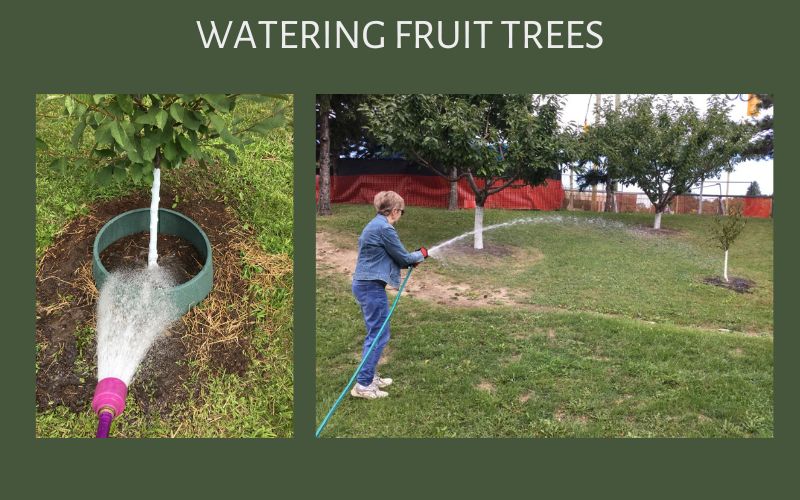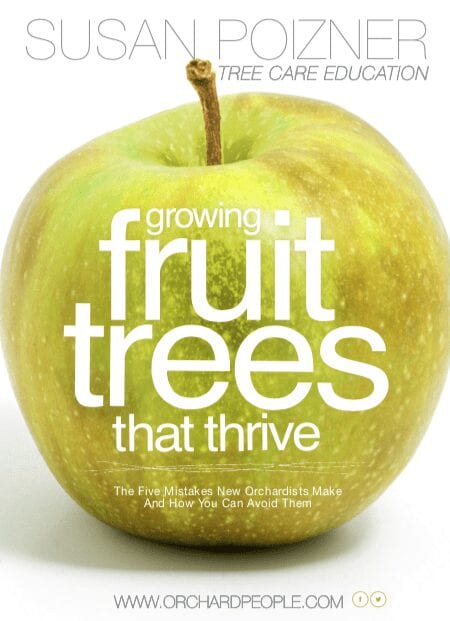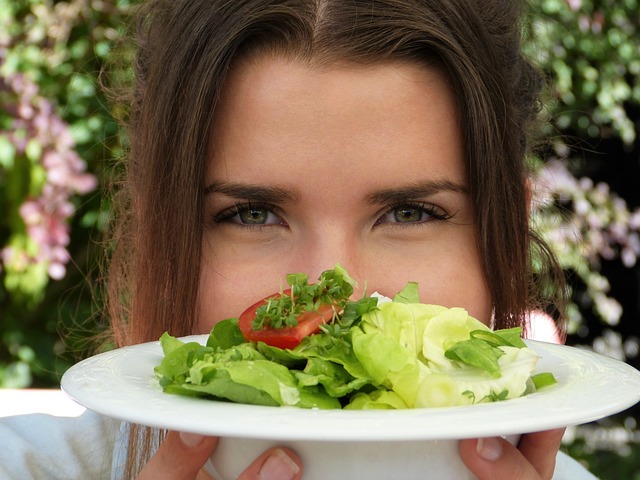
A few years ago, a neighbor planted several fruit trees in his yard. The trees weren’t thriving and so he asked me to have a look. It was clear that there was a problem. The trees looked weak and spindly and their leaves were wilting. So I asked him how often he watered them.
“Fruit trees don’t need water,” he shrugged. He clearly hadn’t been watering them at all.
Now, this neighbor is a medical doctor and he knows a lot about keeping humans healthy. But like many of us, he isn’t necessarily well informed about fruit tree care.
The problem is that unlike humans, fruit trees don’t have teeth and can’t chew. Whatever nutrition they take in from the soil must be in liquid form.
That means a dehydrated tree is also a nutritionally deficient tree. And a nutritionally deficient tree will not thrive and will not produce a healthy harvest.
In this article we’ll explore the best ways to water fruit trees. Let’s dig in!

The best way to water young fruit trees
How much you water fruit trees depends on various factors including tree age, soil type, climate, season and tree type.
So let’s start with age. Fruit tree irrigation is most important with a young, newly-planted tree because young trees need to establish their root systems. When you’re planting a young tree, you’ll need to water it regularly for 2-3 months until it settles in.
In our community orchard we have clay soil. So, we water newly planted fruit trees twice a week, using 15 gallons of water each time. That’s three buckets for each tree! We slowly pour the water around their root systems, waiting until it is absorbed. Then, we water some more.
Slow, deep watering means that the water won’t pool on the soil’s surface and roll away. And tree roots go down at least 12 inches (30 cm). So we need the water to go down that deep.

But what if your newly planted tree is in sandy soil? Sand doesn’t hold moisture well, so you will need to water more frequently. And in this case, the water won’t have to work its way through dense clay so it will get to the roots faster. That means that less water will be necessary.
The best way to water established fruit trees
When a fruit tree is newly planted, you know where the roots are. After all, you just planted that tree! So you will water the soil just above the roots. But after a few years, the tree will establish itself. Its roots will spread out far and wide. Where should you direct the water then?
Understanding fruit tree anatomy will help us here:
Fruit trees take in water and nutrients primarily through their youngest roots, called “Feeder roots.” These roots are usually located under the outer edge of the canopy. Feeder roots are like little root pioneers, reaching out to access nutrition in soil that the tree hasn’t explored before!
In comparison, those older, woody roots that are closer to the tree don’t take in much water. Their job is to anchor the tree to the ground.
So that explains the biggest secret of how to water fruit trees. You need to put the water in the area where the feeder roots are. To do so, you’ll water around the tree’s drip line, just under the outer edge of the canopy.
According to Robert Kourick, author of Roots Demystified: Changing Your Gardening Habits to Help Roots Thrive, fruit tree roots are shallow and far reaching.
So if we want to encourage tree roots to stretch out more, we should by watering slightly further away from the trunk each year. That will help encourage tree roots to reach out further, making your tree stronger and more productive.
“If you just keep watering, fertilizing a foot away from the trunk, the roots will stay there and they won’t explore a large volume of soil,” he says.

Fruit Tree Care Newsletter
Sign up for our monthly newsletter and we will send you our eBook “Growing Fruit Trees That Thrive.” You can unsubscribe at any time.
While the tree’s roots need water, the trunk, branches and leaves do not. Moreover, if the upper part of the tree becomes too wet, it can become a breeding ground for fungal diseases.
To ensure that doesn’t happen, it’s important to avoid using sprinklers to water your fruit trees. That’s because they will wet the entire tree and not just the roots.
If you can’t use sprinklers, what’s the best way to water your fruit trees? Let’s explore that next.

Drip irrigation, soaker hoses or buckets: Which is the best way to water fruit trees?
Fruit trees like slow, deep watering. And drip irrigation is a very good option. Here are some things to keep in mind.
- Drip irrigation uses a hose with emitters spaced evenly to distribute the water. consistently—about a foot apart for sandy soil and further for clay soil.
- Run drip irrigation hoses on either side of a row of trees in your orchard or spiral around a single tree.
- Don’t bury your drip irrigation hoses as they can become chew toys for gophers. Leave them on the surface.
- On city water systems, you may need a pressure regulator to decrease the water pressure on the emitters.

Robert Kourick has written an eBook on drip irrigation if you learn more about setting a system up.
If you can’t invest in a drip irrigation system there are other options.
- Soaker hoses. These release water slowly over time allowing the tree time to absorb the water. But the water pressure goes down as you get further from the faucet and the tiny holes in soaker hoses can become clogged over time, making them less reliable.
- Dripping hose: Dig a six-inch (15 cm) deep moat around your tree. Fill it with water and let it slowly leak out. You may need to do this a few times or simply leave the hose dripping into the moat for a while until it fully saturates the soil. Expand the circle as the tree ages and the root system expands.
- Leaky buckets: This is an easy way to water fruit trees while you are doing something else. Drill holes into the bottom of a number of five-gallon buckets. Place the buckets around the outer edge of your tree’s root system and let the water slowly leak out. Put the buckets in different locations around the tree to ensure all of the roots get water.
Fruit tree irrigation and mulch
Once you get the water into the soil, you want to keep it there for a while to give the tree’s feeder roots a chance to absorb it. And fruit tree mulches can help.
One popular option is to use 2 inches (5 cm) of wood mulch and spread it over the tree’s root system. Be sure to extend the mulch to the edge of the canopy where the feeder roots are.
The mulch will help keep the moisture in the soil and it can prevent weeds from sprouting and competing with the tree roots for water and nutrition.

But too much of a good thing can be bad! Here are two things to keep in mind when mulching:
- Do not apply mulch too thickly. If you do, it will prevent air from reaching the tree roots. If the roots never dry out after irrigation they are vulnerable to root rot.
- Do not allow the mulch to touch the trunk of the tree. If it does, moist mulch can rot the wood of the trunk and provide an entry point for insect borers.
You can learn more about how to mulch fruit trees in this article.
Winter, Spring, Summer or Fall: When to water fruit trees?
Watering frequency will depend on the time of year, your climate and other factors. Here are some tips to keep in mind when it comes to seasonal watering:
- In cold climates it’s not necessary to water fruit trees in the winter months as growth has slowed.
- In warmer climates you can water occasionally during the winter months especially when it comes to evergreen fruit trees like citrus trees.
- In cold climates, we rarely water fruit trees in the spring because melting snow and frequent rain keep the soil moist. But if it’s a dry spring you will need to water.
- In the summer it is essential to water fruit trees in any climate as the days are long (and often dry) and the sun can get hot. Windy weather can exacerbate dryness so it’s important to irrigate after a windstorm.
- In the fall, the weather has cooled. The days are shorter and so there are fewer hours of sunshine. The soil will not be as dry, so you can slow down watering at that time.
Watering fruit trees: The Bottom Line
Getting the watering right for fruit trees can be a bit tricky! So how can you check if your approach is working?
After you water, just grab a trowel and dig a bit near the tree’s dripline. Check if the soil is moist about 6-12 inches down. If it’s still dry, it’s a sign to keep the water coming!
With time, you’ll get the hang of it and your tree will make it worth your while. As Robert Kourick puts it, “frequent irrigation will produce the most amount of fruit.”
By tuning into your tree’s watering needs, you’ll be well on your way to an abundant annual harvest of organic fruit, year after year.
If you’d like to learn more about fruit tree care, try our Certificate in Fruit Tree Care at orchardpeople.com.

#Water #Fruit #Trees #Boost #Tree #Health #Harvest




